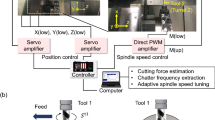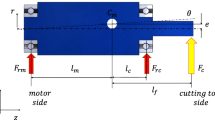Abstract
The aim of growing productivity together with increasing quality demands in machining leads to milling processes that are near their stability limits. The remaining stability reserves become smaller and the risk of unstable processing conditions like chatter increases. Unstable processes cause unwanted vibrations with high amplitudes in bearing loads. As a result, the lifetime of the bearings of the main spindle is reduced. Besides this, the surfaces of unstable processed work-pieces have unwanted chatter marks and do not fulfill the quality demands. To basically avoid unstable processing,a continuous monitoring of the process state is necessary. In this paper, a method for monitoring cutting processes using a standard programmable logic controller which is integrated in the drive controller of the machine tool spindle unit is presented. The method is real time-capable and based on the hypothesis that unstable process conditions result in a modulation of the amplitudes of the cutting forces. To detect this, an order tracking method is implemented, which uses a recursive parameter estimation algorithm together with inherently given signals of the drive controller. It is shown that the characteristic property of the used estimation algorithm and allowed aliasing lead to a reliable chatter detection even at sub-sampling. Finally some results of the first experimental investigation of the method are given.







Similar content being viewed by others
References
Schuh G, Kampker A, Franzkoch B, Wemhöner N (2005) Intelligent maintenance, potenziale zustandsorientierter Instandhaltung/WZL RWTH Aachen und Fraunhofer Institut Produktionstechnologie. Studie. http://www.ifm.com/ifmde/web/studie_ergebnisse.htm
Weck M, Brecher C (2006) Werkzeugmaschinen 3. Springer, Berlin
Altintas Y, Weck M (2004) Chatter stability of metal cutting and grinding. In: CIRP annals—manufacturing technology 53, Nr. 2, S.619–642. doi:10.1016/S0007–8506(07)60032–8. –ISSN 0007–8506
Tönshoff H, Denkena B (2004) Spanen. Springer, New York
Altintaş Y, of British Columbia University (Hrsg.) (2000) Manufacturing automation. Cambridge University Press, Cambridge, MA
Faassen R (2007) Chatter prediction and control for highspeed milling: modelling and experiments. University Press Facilities, Eindhoven
Stépán G (1990) Retarded dynamical systems: stability and characteristic functions. Longman Scientific and Technical, Harlow
Weck M, Teipel K (1977) Dynamisches Verhalten spanender Werkzeugmaschinen. Einflugren, Beurteilungsverfahren, Megren. Springer, New York
Abele E, Dietz S, Schiffler A (2009) Analysis of cutting force during milling with regards to the dependency on the penetration angle. In: production engineering 3:S.483–487. doi:10.1007/s11740–009–0170–4. ISSN 0944–6524
Brecher C, Manoharan D, Ladra U, Kpken HG (2010) Chatter suppression with an active workpiece holder. In: production engineering 4:S.239–245. doi:10.1007/s11740–009–0204–y. ISSN 0944–6524
Wolf CM, Lorenz RD (2010) Using the motor drive as a sensor to extract spatially dependent information during servo operation. In: energy conversion congress and exposition (ECCE). IEEE, S.4474–4481
Wang KS, Heyns PS (2009) Vold-Kalman filter order tracking in vibration monitoring of electrical machines. J Vibration Control 15, Nr. 9, S.1325–1347. doi:10.1177/1077546308094431
Tuma J (2001) Vold-Kalman order tracking filtration as a tool for machine diagnostics. In: engineering mechanics. Svratka, Czech Republic
Bai MR, Jeng J, Chen Ch (2002) Adaptive order tracking technique using recursive least-square algorithm. J Vibration Acoust 124:Nr.4, S.502–511. doi:10.1115/1.1501301
Isermann R (1988) Identifikation dynamischer systeme— Grundlegende methoden. Bd. I. Springer, New York
Oppenheim AV, Schafer RW (1995) Zeitdiskrete signalverarbeitung. R. Oldenburg Verlag Mnchen Wien, (2., neubersetzte und berarbeitete Auflage)
Schuessler HW (2008) Digitale signalverarbeitung 1 analyse diskreter signale und systeme. Springer (5., neu bearbeitete und ergaenzte Auflage)
Author information
Authors and Affiliations
Corresponding author
Rights and permissions
About this article
Cite this article
Abele, E., Sielaff, T. & Schiffler, A. Method for chatter detection with standard PLC systems. Prod. Eng. Res. Devel. 6, 611–619 (2012). https://doi.org/10.1007/s11740-012-0411-9
Received:
Accepted:
Published:
Issue Date:
DOI: https://doi.org/10.1007/s11740-012-0411-9




